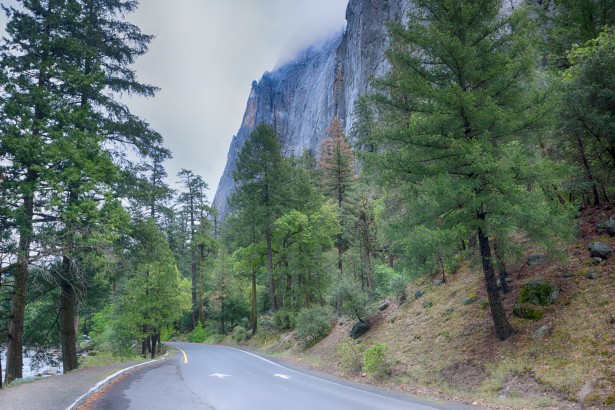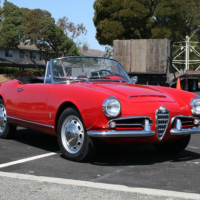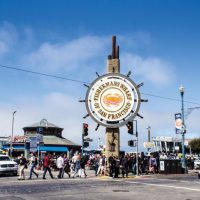
This is the continuing saga of my first Alfa Romeo. It was a red 1963 Giulia Spider Normale. I bought it in 1968 when I was 17 years old.
It was an exotic, alloy-engine, twin-camshaft sports car. I tried to maintain it on a shoestring budget. This lead to many types of improvised roadside repairs.
During the summer of 1968 I was following my friend Bjarne Holm, who was driving his mother’s white 1958 Giulietta Spider Normale. We started out from San Francisco and headed for our favorite weekend destination, Yosemite National Park.
In those days, Yosemite wasn’t the zoo that is today. You could always find a place to camp on the valley floor. Reservations were unheard of.
We were driving down State Highway 242, headed towards Groveland and the Big Oak Flat entrance to the park.
My family had roots in the Gold Rush town of Groveland. My grandmother, Dorel Evelyn Gray, was born there.
My grandfather, Thomas Lester McDowell, came west from his home in Cozad, Nebraska looking for work during the depression. My grandparents raised me from birth, which is another story.
Gramps managed to buy a Model T. Grandma bragged that whenever he came courting, he had fresh-cut flowers in the vase attached to his dashboard.
My grandmother often told the story of how she got her first driver’s license by clipping an application form from the side of a breakfast cereal box and mailing it in.
My grandfather maintained my grandmother never wore shoes until she met him — a statement she fervently denied.
My grandmother’s sister, Bessie and her husband Mitch lived in Groveland — in a house than my grandfather had helped build.
When we visited them, at the age of 6 my job was to collect eggs from the chicken coop each morning for breakfast. I was also told to be careful of the bobcats and bears when walking outside at night. For a city boy, it was a strange and slightly fearsome introduction to the Gold Rush country of Northern California.
I recall prowling the acreage with my grandfather, as he pointed out the different types of trees, mostly oak and pine, and the various mineral formations that showed the possibility of gold.
There was old army jeep there at Uncle Mitch and Aunt Bessie’s. My grandfather enjoyed giving us Disneyland-style joy rides through the backcountry. I can recall hanging on for dear life — equal parts scared and exhilarated — as we bounced along.
Snips and tin cans
On the highway, I saw sparks coming out from under Bjarne’s car.
Suddenly his whole exhaust system — including two mufflers — fell off from the exhaust manifold to the tailpipe.
I jerked the steering wheel left to dodge it and watched it bounce two or three times and come to rest next to the center divider.
We both stopped near the exhaust pipe. It had bent in half and was nearly split open.
Bjarne wrapped some rags around it. We always had lots of rags in our cars then, as they were continually leaking fluids of all types, from oil to brake fluid to coolant. He put the pipe into the passenger side of his car and we drove on until we found a gas station.
It those days gas stations actually had mechanics in them who were prepared to help you fix you car.
Bjarne straightened out the pipe and laid it on the ground. He finished breaking the bent pipe into two parts, and used some water pump pliers to open up both pinched ends and make them round again.
Then he bought a soft drink and two hose clamps from the station. He drank the pop, borrowed some tin snips from the station, clipped the two ends of the pop can off, slit it down the center and flattened it out.
Then he joined the two ends of the exhaust pipe by wrapping the soda pop can around them. He secured each end with a hose clamp.
As we were both skinny and nimble then, I helped him bolt the pipe back onto the exhaust header without jacking the car up. We reattached the rubber exhaust hangers. Within 30 minutes, our fingers only slightly greasy, we were back on the road.
We reached Yosemite that night and pitched our tents, ready to enjoy a weekend of partying with the other campers and racing around the glorious Yosemite roads.
Nearly every time we visited, we drove over the Sierra Nevada Mountains on Tioga Pass road — elevation 9,943 feet. I don’t know if I was more pressed by the glacier-carved granite or that my oxygen-starved engine was still able to pull strongly in the thin air.
We car boys had our priorities.
We would reach salty, brine-filled Mono Lake, turn around and head home.
Almost 40 years later, in 2005, SCM legal analyst John Draneas and I retraced this route in a Ford GT that I was reviewing for the New York Times. No mufflers fell off of that car.


Keith: Thanks for the blog and the memories of Yosemite roads. I often grove up there to backpack in the 70s, and later and loved the drive, especially Highway 120 before it was widened, driving looking up at the opening in the trees in my ‘71 911E.
Thanks for the memories.
Wonderful story Keith. Love the stuff about your grandparents.
Awesome, two teenagers with their own Sports Cars off on an excellent adventure. Making roadside repairs with borrowed tools and inexpensive makeshift supplies. Then continuing the journey. Reminded me of assisting my Father accomplish many similar repairs in the 1960/70’s on old Fiat Roadsters (1200-1500cc), Mustang, VWs, Cadillacs, and others. As I grew up in NYC it was common for us to use a curb as an improvised jack (put one or two wheels up on the curb) so you could slide under with a couple of wrenches to change a Starter or similar. Tools, rags, oil, coil, points, test light, etc were always carried in the trunk. Proper Preflight Planning Prevents Poor Performance. Today’s cars have lessened a mechanically inclined person’s interaction to oil and fluid changes. And maybe brake work. Also the reliability today is incredible compared to cars that were built back in the day. Digital is great but hard to beat the experience of Analog.